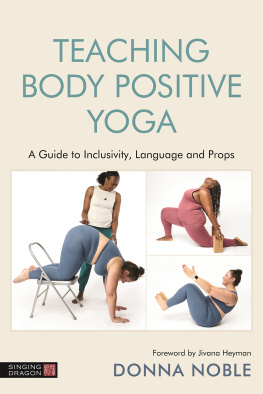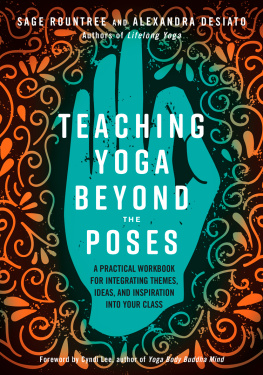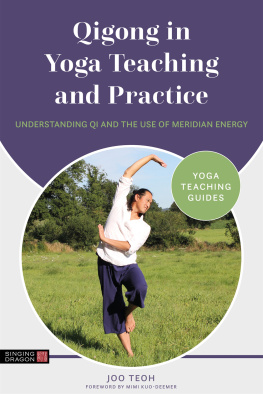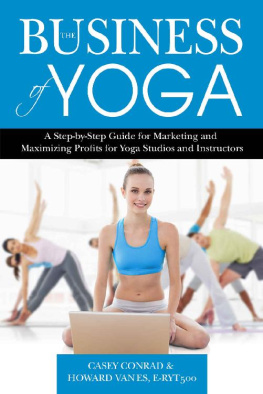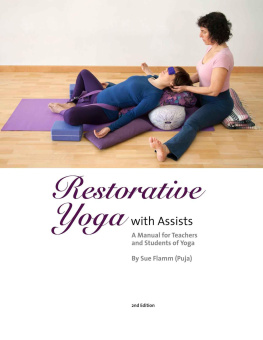Introduction
All of us who choose to teach yoga want to make a positive difference in our students lives. As our industry and class sizes have grown, our continuing education has become even more important. Many new teachers are asked at gyms and yoga studios to teach large, mixed level classes that even experienced yoga teachers would struggle to teach well. It can be overwhelming when we arrive to teach class and see that it includes a wide variety of people and fitness levels. The increasing popularity of yoga in the last decade has brought everyone we can imagine into our classes. We may find a middle-aged mom, a retired insurance salesman, a former dancer, a college student, and even our own mother all in the same class! What do we do to keep everyone happy and healthy? In my years of teaching yoga, Ive faced this situation time and again, and with this book I share the teaching methodology that Ive developed to work effectively with the students that attend my classes and trainings. Although Ive written this book for new teachers and those attending their first trainings, I believe more experienced teachers may also find some ideas to try in their classes.
My approach to teaching began to develop early on when I became frustrated with how many students came and went from the classes I was teaching at a local gym. Some students did stay, and some have been coming to my classes since I first started teaching, but many students left to pursue some other fitness class within six months. Once I started my own studio, the percentage of people who stayed in classes and became part of the studio community increased, but I still found the average student stayed for less than a year. I realized that if I was going to continue owning a studio, I had to accept that this revolving door was part of the business. Over the years Ive had conversations with gym managers, owners of yoga studios, and owners of Pilates studios, who all confirmed experiencing the same thing. As this reality of constant turnover in classes became apparent, I began considering the best way to teach in this environment. What can we best impart to our students in an average of six months that will make the biggest positive impact in their lives? I believe the first skill to introduce is breath awareness. Next, we must focus on basic body awareness to address the modern postural issues created by our electronic devices and sedentary lifestyle. Finally, students need to learn to relax with the practice of Shavasana.
Whether we are teaching yoga or some other physical activity there are movement fundamentals that we can teach to help students become more deeply connected with the body. In order to move efficiently, effectively, and safely, students need to learn these basics. Over time Ive developed what I like to call the 10 Yoga Movement Fundamentals. My ideas when creating these fundamentals were influenced by my studies in yoga therapy, my Pilates training with Balanced Body and their Pilates movement principles, and discussions with a number of college-level dance students who attended my trainings. I list the breath first to indicate that it is the most important, and then I start with the feet and move upward for ease of organization of this book.
The 10 Yoga Movement Fundamentals
- Breath Awareness
- Opening and Grounding the Feet
- Aligning the Ankles and Knees
- Activating the Quadriceps and Glutes
- Stretching the Hips Carefully
- Awakening the Core and Stabilizing the Pelvis
- Freeing the Spine
- Stabilizing the Shoulders and Opening the Chest
- Supporting the Wrists, Hands, and Elbows
- Realigning the Head and Neck
For some students these fundamentals are easy to pick up and execute, but for many they must be practiced again and again. As students begin to gain understanding and strengthen the mind-body connection they will be able to apply a fundamental in one pose, but not necessarily in another. It takes time and patience for students to understand what the teacher is requesting, to have the ability to embody the subtle cues, and to gain the awareness of a deeper yoga practice. However, I believe that if students leave our classes with a better understanding of at least some of these fundamentals, then weve helped them forge a healthier path forward.
I teach these fundamentals through creative cueing and the use of a variety of props. Each chapter in this book covers one of the movement fundamentals in detail, along with cueing ideas, sequencing suggestions, and step-by-step practices for you to explore. The practices in this book are for teachers to try different cues and see what they find. They are for exploration and are not intended for memorization or repeating to students. Most students can only process 3 or 4 verbal cues for each posture at one time. Once students have heard a cue for a while, they will decide that they know what it means (even if they dont) and stop listening. So, to be effective at teaching, we have to vary our cues and change our sequences to keep their attention.
My focus on verbal cueing is intentional. For many years the centerpiece of yoga teacher trainings has been the physical adjustments, with the idea that doing a lot of touching and adjusting is the measure of what makes a great yoga teacher. After learning the common physical adjustments many years ago, I became aware that some students were uncomfortable receiving these adjustments, and in addition some students became overly interested in getting physical adjustments creating boundary issues. Most importantly, I discovered that physical adjustments do not always help the student make their own pose better. To be effective teachers we need more options than just relying on physical adjustments, with a toolbox of both verbal and visual cues.
As our teaching skills grow and develop, our students will learn more quickly how to create their own yoga without depending on us. Being a great yoga teacher is about guiding students to make their own lives a little better through the practice.
Guiding Breath Awareness
L ike many yoga teachers, discovering my breath and learning to meditate created a form of awakening, an internal shift within me. This experience was the spark that started my interest in teaching yoga. I wanted to share what I discovered with others. Now as a teacher trainer I hear from students wanting to become yoga teachers, and they all tell me a similar story. Each one of them attempts to put into words some kind of spiritual experience that has occurred, but they dont quite know how to explain it. What they can easily express is that their life is better with yoga, and they want to help others by passing it on.
For many of us, connecting with the rhythm of our breathing and with the accompanying sensations and feelings creates a foundation of awareness that often leads to a spiritual experience. Its that experience that we want to share, that we want so much for others to find. It is what has impelled me to continue to try to teach yoga despite the challenges. But I cant really explain it, and neither can the people calling me on the phone to inquire about teacher training.
Ive come to believe that the experience of the breath just happens to people. Its not something that can be controlled or forced. As the teacher I can only create a safe space and situation in which some kind of experience might take place. I am not the doer of this transformation, nor do I take any credit for it. Although I am attempting to teach students about their breath when showing them breathing exercises called pranayama, I consider myself a guide more than a teacher.




